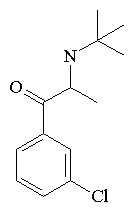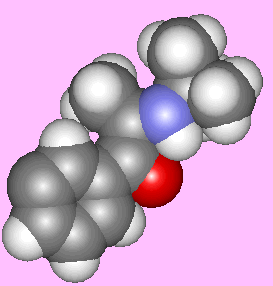

Jamie Harris and Dr. Bernard Blessington
Pharmaceutical Chemistry, Bradford University, UK

This month's MOTM is the result of a Chemistry-based web browser race held in the Pharmaceutical Chemistry Department of Bradford University. In this, students on the course were asked the question: "What is Zyban and its uses?", and they had to race to find the relevant information using web-based resources. The first student to obtain sufficient information, including 3D chemical structures, medical uses, side-effects, etc, won the prize. This year it was won by Jamie Harris, a 1st Year Pharmacy undegraduate at Bradford, who obtained the following information in one day. |
Zyban is a drug marketed by Glaxo-Wellcome and has been used, very successfully, to treat nicotine addiction directly. In this case it is different to the way other anti-smoking agents work, such as nicotine gum and patches, since these simply supply an alternative source of nicotine other than cigarettes. Zyban works at the neurological level, reducing the craving for nicotine in any form. At the moment it is licensed in the US, but not yet in the UK. It is potentially extremely important, as this discovery could open the door to finding similar molecules for treating much more serious addiction problems, such as cocaine and heroin, etc.
 Zyban (bupropion hypochloride) Also available (left-click to download): |
 |
The active ingredient in Zyban is bupropion, a relatively weak inhibitor of the neuronal uptake of dopamine, serotonin and norepinephrine. Chemically, bupropion is related to phenylethylamines and has a relative molecular weight of 276.2. Although, bupropion was initially marketed as an anti-depressant (Wellbutrin), it is chemically unrelated to tricyclic, tetracyclic, selective serotonin reuptake inhibitors or other known anti-depressants.
The pharmacokinetics of bupropion is best described by a two-compartment model with a distribution phase (how long it takes for the drug to be absorbed into the body and begin working) having a mean half-life of 3-4 hours, and an elimination phase (how long it takes for it to be metabolised and broken down to inert waste products) which has a half-life of 21 hours. Bupropion is extensively metabolized into three active metabolites. At least one of these metabolites is formed by an enzyme called cytochrome P-450 2B6 enzyme. The terminal half-life of the three metabolites ranges from 21 to 37 hours. This means that it may interact with other drugs which also effect this enzyme, such as orphenadrine and cyclophosphamide. The main known side-effects of zyban are dry mouth and dizziness, although there are a few others.
The recommended and maximum dose of Zyban is 300 mg/day given as 150 mg tablets, twice daily. Treatment is usually initiated while the patient is still smoking and the target date for smoking cessation is normally within the first two weeks of Zyban treatment. Zyban therapy then continues for 7 to 12 weeks, depending on the effect of the therapy. If the patient has not reduced smoking by the seventh week of Zyban therapy, it is unlikely that he/she will quit during that attempt and Zyban therapy is normally discontinued.
More information about Zyban, including other side effect, drug interactions, and the results of clinical trials on its effectiveness as an aid in smoking cessation can be found on a separate page.
July 1999.

![]() Back to Molecule of the Month page.
[DOI:10.6084/m9.figshare.5462434]
Back to Molecule of the Month page.
[DOI:10.6084/m9.figshare.5462434]